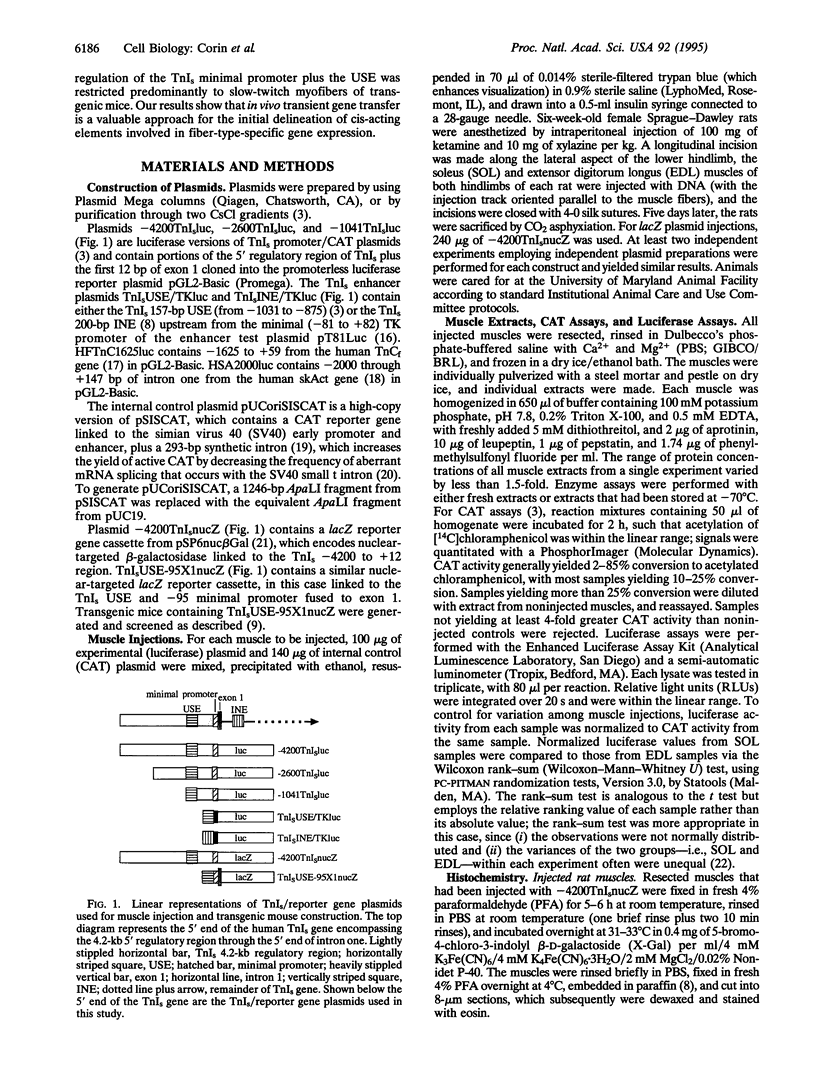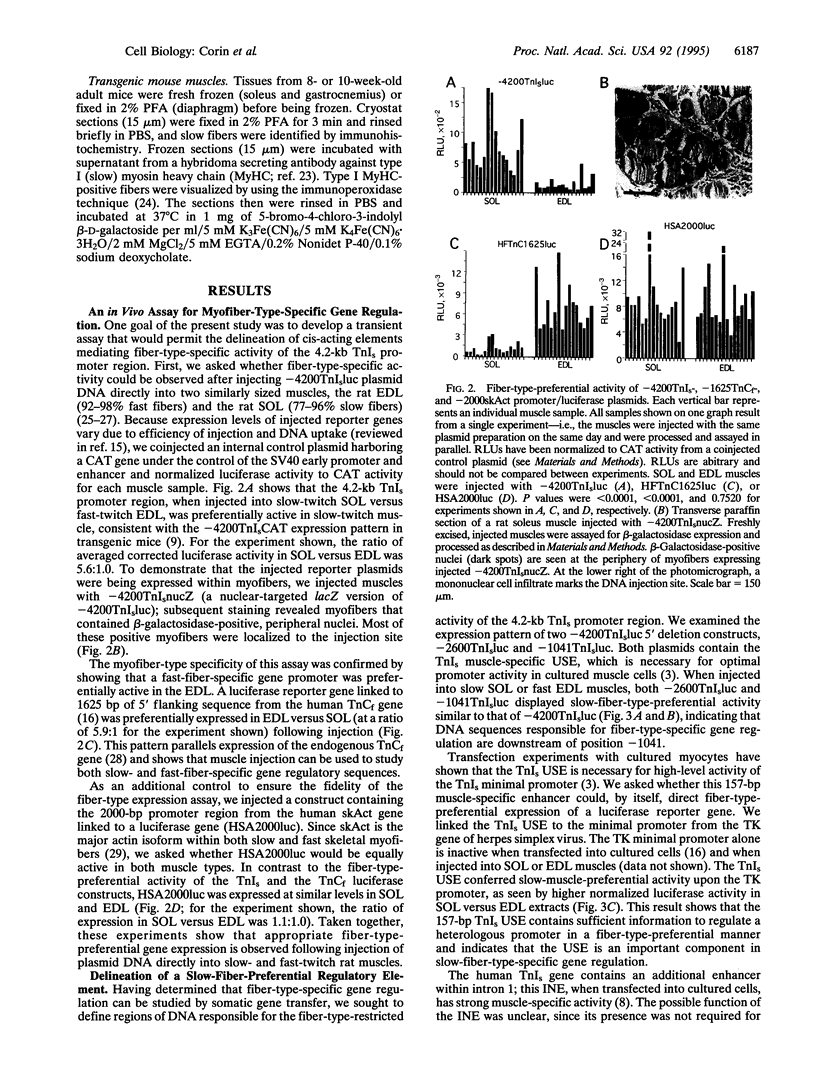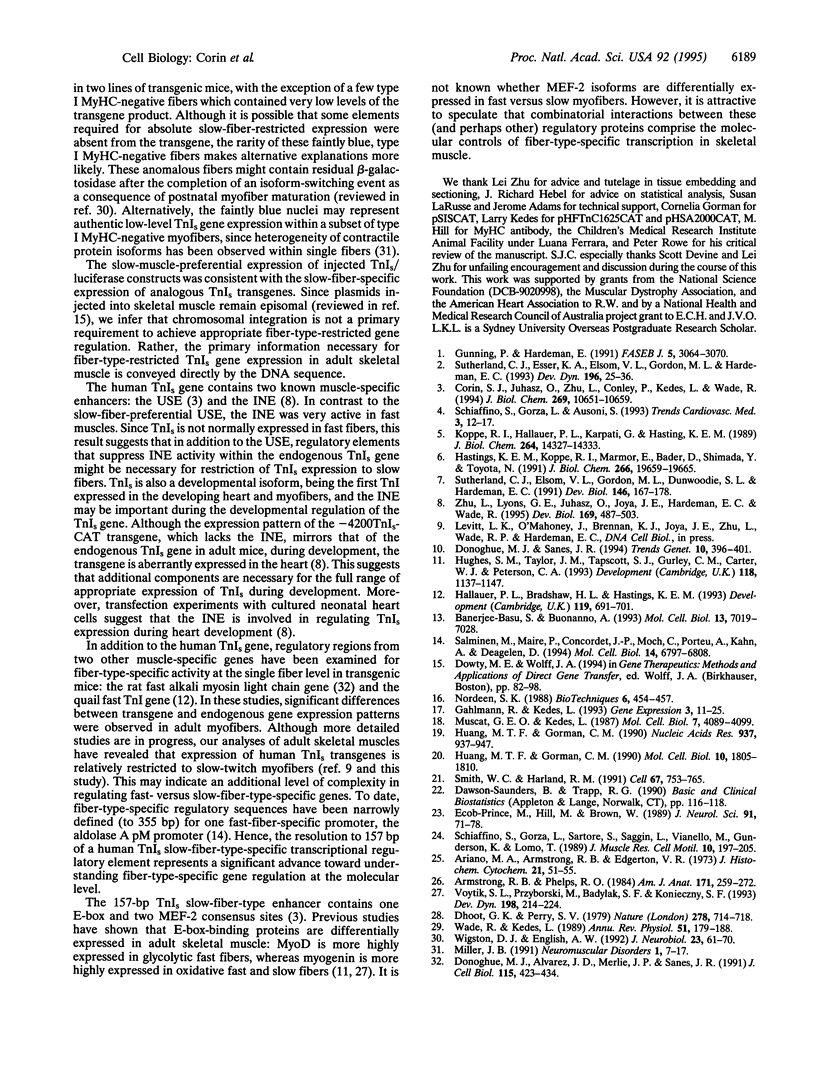Abstract
Contractile proteins are encoded by multigene families, most of whose members are differentially expressed in fast- versus slow-twitch myofibers. This fiber-type-specific gene regulation occurs by unknown mechanisms and does not occur within cultured myocytes. We have developed a transient, whole-animal assay using somatic gene transfer to study this phenomenon and have identified a fiber-type-specific regulatory element within the promoter region of a slow myofiber-specific gene. A plasmid-borne luciferase reporter gene fused to various muscle-specific contractile gene promoters was differentially expressed when injected into slow- versus fast-twitch rat muscle: the luciferase gene was preferentially expressed in slow muscle when fused to a slow troponin I promoter, and conversely, was preferentially expressed in fast muscle when fused to a fast troponin C promoter. In contrast, the luciferase gene was equally well expressed by both muscle types when fused to a nonfiber-type-specific skeletal actin promoter. Deletion analysis of the troponin I promoter region revealed that a 157-bp enhancer conferred slow-muscle-preferential activity upon a minimal thymidine kinase promoter. Transgenic analysis confirmed the role of this enhancer in restricting gene expression to slow-twitch myofibers. Hence, somatic gene transfer may be used to rapidly define elements that direct myofiber-type-specific gene expression prior to the generation of transgenic mice.
Full text
PDF




Images in this article
Selected References
These references are in PubMed. This may not be the complete list of references from this article.
- Ariano M. A., Armstrong R. B., Edgerton V. R. Hindlimb muscle fiber populations of five mammals. J Histochem Cytochem. 1973 Jan;21(1):51–55. doi: 10.1177/21.1.51. [DOI] [PubMed] [Google Scholar]
- Armstrong R. B., Phelps R. O. Muscle fiber type composition of the rat hindlimb. Am J Anat. 1984 Nov;171(3):259–272. doi: 10.1002/aja.1001710303. [DOI] [PubMed] [Google Scholar]
- Banerjee-Basu S., Buonanno A. cis-acting sequences of the rat troponin I slow gene confer tissue- and development-specific transcription in cultured muscle cells as well as fiber type specificity in transgenic mice. Mol Cell Biol. 1993 Nov;13(11):7019–7028. doi: 10.1128/mcb.13.11.7019. [DOI] [PMC free article] [PubMed] [Google Scholar]
- Corin S. J., Juhasz O., Zhu L., Conley P., Kedes L., Wade R. Structure and expression of the human slow twitch skeletal muscle troponin I gene. J Biol Chem. 1994 Apr 8;269(14):10651–10659. [PubMed] [Google Scholar]
- Dhoot G. K., Perry S. V. Distribution of polymorphic forms of troponin components and tropomyosin in skeletal muscle. Nature. 1979 Apr 19;278(5706):714–718. doi: 10.1038/278714a0. [DOI] [PubMed] [Google Scholar]
- Donoghue M. J., Alvarez J. D., Merlie J. P., Sanes J. R. Fiber type- and position-dependent expression of a myosin light chain-CAT transgene detected with a novel histochemical stain for CAT. J Cell Biol. 1991 Oct;115(2):423–434. doi: 10.1083/jcb.115.2.423. [DOI] [PMC free article] [PubMed] [Google Scholar]
- Donoghue M. J., Sanes J. R. All muscles are not created equal. Trends Genet. 1994 Nov;10(11):396–401. doi: 10.1016/0168-9525(94)90056-6. [DOI] [PubMed] [Google Scholar]
- Ecob-Prince M., Hill M., Brown W. Immunocytochemical demonstration of myosin heavy chain expression in human muscle. J Neurol Sci. 1989 Jun;91(1-2):71–78. doi: 10.1016/0022-510x(89)90076-2. [DOI] [PubMed] [Google Scholar]
- Gahlmann R., Kedes L. Tissue-specific restriction of skeletal muscle troponin C gene expression. Gene Expr. 1993;3(1):11–25. [PMC free article] [PubMed] [Google Scholar]
- Gunning P., Hardeman E. Multiple mechanisms regulate muscle fiber diversity. FASEB J. 1991 Dec;5(15):3064–3070. doi: 10.1096/fasebj.5.15.1835946. [DOI] [PubMed] [Google Scholar]
- Hallauer P. L., Bradshaw H. L., Hastings K. E. Complex fiber-type-specific expression of fast skeletal muscle troponin I gene constructs in transgenic mice. Development. 1993 Nov;119(3):691–701. doi: 10.1242/dev.119.3.691. [DOI] [PubMed] [Google Scholar]
- Huang M. T., Gorman C. M. Intervening sequences increase efficiency of RNA 3' processing and accumulation of cytoplasmic RNA. Nucleic Acids Res. 1990 Feb 25;18(4):937–947. doi: 10.1093/nar/18.4.937. [DOI] [PMC free article] [PubMed] [Google Scholar]
- Huang M. T., Gorman C. M. The simian virus 40 small-t intron, present in many common expression vectors, leads to aberrant splicing. Mol Cell Biol. 1990 Apr;10(4):1805–1810. doi: 10.1128/mcb.10.4.1805. [DOI] [PMC free article] [PubMed] [Google Scholar]
- Hughes S. M., Taylor J. M., Tapscott S. J., Gurley C. M., Carter W. J., Peterson C. A. Selective accumulation of MyoD and myogenin mRNAs in fast and slow adult skeletal muscle is controlled by innervation and hormones. Development. 1993 Aug;118(4):1137–1147. doi: 10.1242/dev.118.4.1137. [DOI] [PubMed] [Google Scholar]
- Koppe R. I., Hallauer P. L., Karpati G., Hastings K. E. cDNA clone and expression analysis of rodent fast and slow skeletal muscle troponin I mRNAs. J Biol Chem. 1989 Aug 25;264(24):14327–14333. [PubMed] [Google Scholar]
- Muscat G. E., Kedes L. Multiple 5'-flanking regions of the human alpha-skeletal actin gene synergistically modulate muscle-specific expression. Mol Cell Biol. 1987 Nov;7(11):4089–4099. doi: 10.1128/mcb.7.11.4089. [DOI] [PMC free article] [PubMed] [Google Scholar]
- Nordeen S. K. Luciferase reporter gene vectors for analysis of promoters and enhancers. Biotechniques. 1988 May;6(5):454–458. [PubMed] [Google Scholar]
- Salminen M., Maire P., Concordet J. P., Moch C., Porteu A., Kahn A., Daegelen D. Fast-muscle-specific expression of human aldolase A transgenes. Mol Cell Biol. 1994 Oct;14(10):6797–6808. doi: 10.1128/mcb.14.10.6797. [DOI] [PMC free article] [PubMed] [Google Scholar]
- Smith W. C., Harland R. M. Injected Xwnt-8 RNA acts early in Xenopus embryos to promote formation of a vegetal dorsalizing center. Cell. 1991 Nov 15;67(4):753–765. doi: 10.1016/0092-8674(91)90070-f. [DOI] [PubMed] [Google Scholar]
- Sutherland C. J., Esser K. A., Elsom V. L., Gordon M. L., Hardeman E. C. Identification of a program of contractile protein gene expression initiated upon skeletal muscle differentiation. Dev Dyn. 1993 Jan;196(1):25–36. doi: 10.1002/aja.1001960104. [DOI] [PubMed] [Google Scholar]
- Voytik S. L., Przyborski M., Badylak S. F., Konieczny S. F. Differential expression of muscle regulatory factor genes in normal and denervated adult rat hindlimb muscles. Dev Dyn. 1993 Nov;198(3):214–224. doi: 10.1002/aja.1001980307. [DOI] [PubMed] [Google Scholar]
- Wade R., Kedes L. Developmental regulation of contractile protein genes. Annu Rev Physiol. 1989;51:179–188. doi: 10.1146/annurev.ph.51.030189.001143. [DOI] [PubMed] [Google Scholar]
- Wigston D. J., English A. W. Fiber-type proportions in mammalian soleus muscle during postnatal development. J Neurobiol. 1992 Feb;23(1):61–70. doi: 10.1002/neu.480230107. [DOI] [PubMed] [Google Scholar]
- Zhu L., Lyons G. E., Juhasz O., Joya J. E., Hardeman E. C., Wade R. Developmental regulation of troponin I isoform genes in striated muscles of transgenic mice. Dev Biol. 1995 Jun;169(2):487–503. doi: 10.1006/dbio.1995.1163. [DOI] [PubMed] [Google Scholar]






